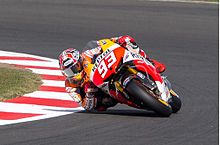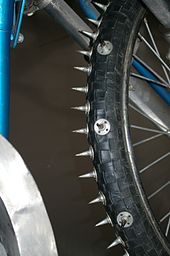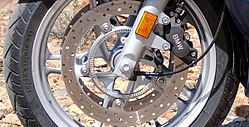Motorcycle tyre

A motorcycle tyre (spelt tire in
History
The history of motorcycle tyres is a clear progression of steady improvement in grip, allowing better acceleration, braking, and turning, along with improved comfort, safety, durability, and reliability. This progression has generally meant a steady increase in tyre width, so much so that Kevin Cameron noted the assumption among riders that "bigger must be better in every way", leading to, "the temptation to overwhelm motorcycles with the biggest tyres the owner can find."[3] While many advances in tyre materials and construction have yielded unalloyed benefits, at a given level of technological sophistication, every design choice, such as tyre width, diameter, cross-section curvature, and the geometry of the motorcycle the tyres are intended for is a trade-off and a compromise.[3]

B: Continuous, one-piece, or open-end inner tube assembly, where first a joint is made where one end slips into the other, with the collar member forced out tightly against the inner face of the retaining member.
C: A butt-end tube, where the tapered, closed end fits into the open end, expanding to seal when inflated.[7]
The early wheels were spoked, made of all metal, or wood and metal, and used
As the early motorcycle industry progressed, larger tyre sizes accompanied larger
From 1915 to 1929, tyre quality continued to increase, and beaded edge tyres began to be replaced by wired-on beads, which used steel loops embedded in the tyre's edge to prevent it from expanding under pressure, so the bead no longer needed a grooved rim to hold it in place.[6] Banded-edge tyre were obsolete and replaced entirely by the wired-on type by 1930.[6] In the period 1956–1964, typical tyre grip increased by 40%, resulting in better cornering, shorter stopping distance and overall improved safety.[6] This was the result of a greater range of tyre sizes appearing on the market, from small 3.5 in × 8 in (89 mm × 203 mm) scooter tyres through 4.5 in × 19 in (110 mm × 480 mm) heavyweight motorcycle tyres. A variety of rubber compounds and tread patterns further expanded the options, specialized for wet roads, smooth dry roads, racing, off-road use, and sidecars.[6] Both natural and synthetic rubber were used, and tyres included fibres of cotton, nylon, and rayon for various structural benefits.[6]
During the 1970s, the increasing widths of tyres led to major changes in
The first

Changing tyre technology continued to influence riding style in 2013 in
Types
Motorcycle tyres are available for many different applications, including: Sport, Sport Touring, Touring, Cruiser, Scooter, On/Off Road, Dual-Sport, Enduro, Motocross and Racing. There are tyres designed for dirtbikes, touring, sport and cruiser bikes. | Sport/performance tyres provide excellent grip but may last 1,000 miles (1,609 km) or less. Cruiser and "sport touring" tyres try to find the best compromise between grip and durability. There is also a type of tyre developed specifically for racing. These tyres offer the highest of levels of grip for cornering. Because of the high temperatures at which these tyres typically operate, use on the street is unsafe as the tyres will typically not reach optimum temperature before a rider arrives at the destination, thus providing almost no grip en route. In racing situations, racing tyres would normally be brought up to temperature in advance by the use of tyre warmers.
Sport Touring tyres are generally not used for high cornering loads, but for long straights, good for riding across the country.
Sport Street tyres are for aggressive street riders that spend most of their time carving corners on public roadways. These tyres do not have a long life, but in turn have better traction in high speed cornering. Street and sport street tyres have good traction even when cold, but when warmed too much, can actually lose traction as their internal temperature increases.
Track or Slick tyres are for track days or races. They may have more of a triangular profile, which in turn gives a larger contact patch while leaned over.[15] These tyres are not recommended for the street by manufactures, and are known to have a shorter life on the street. Due to the triangulation of the tyre, there will be less contact patch in the centre, causing the tyre to develop a flat spot quicker when used to ride on straightaways for long periods of time and have no tread so they lose almost all grip in the wet. Racing slicks are always made of a softer rubber compound and do not provide as much traction as street tyres until warmed to a higher internal temperature than street tyres normally operate at. Most street riding will not put a sufficient amount of friction on the tyre to maintain the slick's optimal tyre temperature, especially in colder climates and in spring and fall.

Cruiser tyres are relatively new. Until recently other tires would be used for cruisers, resulting in a tyre that wasn't quite right for cruising. Sport tyres for example, were often used to enhance the appearance of the bike, even if the bike doesn't have the power to use the tyres to their full extent. Cruiser tyres are often thinner and fatter than sports tyres, meant for a good grip and smooth ride. They are often decorated with custom rims, whitewalls, or tire stickers.
Dual-sport tyres have grooves that flow through from one side of the tyre to the other forming islands of tread, they are classified as 40/60 or 60/40 as in designed for time spent 40% on road, 60% offroad and vice versa, 40/60 has much smaller tread islands than 60/40 for increased traction offroad
Off road tyres have
Touring tyres are usually made of harder rubber for greater durability. They may last longer, but they tend to provide less outright grip than sports tyres at optimal operating temperatures. The tradeoff is that touring tyres typically offer more grip at lower temperatures, meaning they can be more suitable for riding in cold or winter conditions whereas a sport tyre may never reach the optimal operating temperature.
Properties
There are several properties of motorcycle tyres that influence the performance, handling, and stability of a motorcycle.
- Rolling resistance is the resistance that occurs when a tyre rolls on a flat surface. The rolling resistance coefficients of motorcycle tyres are about 0.02.[1] It tends to increase with forward speed and decrease as inflation pressures increase.[1]
- Cornering force is the lateral (i.e. parallel to the road surface) force produced by a vehicle tyre during cornering. Cornering force coefficients of motorcycle tyres tends to decrease with increased vertical load, increased inflation pressure, and increased temperature.[1]
- Camber thrust is the force generated perpendicular to the direction of travel of a rolling tyre due to its camber angle and finite contact patch.
- Pneumatic trail is a trail-like effect generated by compliant tyres rolling on a hard surface and subject to side loads, as in a turn. It is the distance that the resultant cornering force of side-slip occurs behind the geometric centre of the contact patch.
- Relaxation length describes the delay between when a slip angle is introduced and when the cornering force reaches its steady-state value.
Dual-compound tyres
Since about 2005 many manufacturers are producing rear tyres with the centre made of harder, long lasting rubber and the edges made from softer material, often high in silica. Most road bike manufacturers now specify these dual compound tyres as standard equipment due to their proven performance advantage. Single-compound tyres tend to wear down the centre strip well before the sides are worn out. The superior grip of the softer side material allows better grip at more extreme angles in dual compound construction.
Speed and construction
As with four-wheeled vehicles, tyres for motorcycle have a
- 3 digit number: The "nominal section width" of the tyre in millimetres; the widest point from both outer edges.
- /: Slash character for character separation.
- 2 or 3 digit number: The "aspect ratio" of the sidewall height to the total width of the tyre, as a percentage.
- An optional letter indicating construction of the fabric carcass of the tyre:
- B: bias belt (where the sidewalls are the same material as the tread, leading to a rigid ride)
- D: diagonal
- R: radial
- if omitted, then it is a cross ply tyre
- 2 digit number: Diameter in inches of the wheel that the tyre is designed to fit.
- 2 or 3 digit number: Load index; see table below
- 1 or 2 digit/letter combo: Speed rating; see table below
| LI | kg | LI | kg | LI | kg | LI | kg | LI | kg |
|---|---|---|---|---|---|---|---|---|---|
| 19 | 77,5 | 36 | 125,0 | 53 | 206 | 70 | 335,0 | 87 | 545,0 |
| 20 | 80,0 | 37 | 128,0 | 54 | 212,0 | 71 | 345,0 | 88 | 560,0 |
| 21 | 82,5 | 38 | 132,0 | 55 | 218,0 | 72 | 355,0 | 89 | 580,0 |
| 22 | 85,0 | 39 | 136,0 | 56 | 224,0 | 73 | 365,0 | 90 | 600,0 |
| 23 | 87,5 | 40 | 140,0 | 57 | 230,0 | 74 | 375,0 | 91 | 615,0 |
| 24 | 90,0 | 41 | 145,0 | 58 | 236,0 | 75 | 387,0 | 92 | 630,0 |
| 25 | 92,0 | 42 | 150,0 | 59 | 243,0 | 76 | 400,0 | 93 | 650,0 |
| 26 | 95,0 | 43 | 155,0 | 60 | 250,0 | 77 | 412,0 | 94 | 670,0 |
| 27 | 97,5 | 44 | 160,0 | 61 | 257,0 | 78 | 425,0 | 95 | 690,0 |
| 28 | 100,0 | 45 | 165,0 | 62 | 265,0 | 79 | 437,0 | 96 | 710,0 |
| 29 | 103,0 | 46 | 170,0 | 63 | 272,0 | 80 | 450,0 | 97 | 730,0 |
| 30 | 106,0 | 47 | 175,0 | 64 | 280,0 | 81 | 462,0 | 98 | 750,0 |
| 31 | 109,0 | 48 | 180,0 | 65 | 290,0 | 82 | 475,0 | 99 | 775,0 |
| 32 | 112,0 | 49 | 185,0 | 66 | 300,0 | 83 | 487,0 | 100 | 800,0 |
| 33 | 115,0 | 50 | 190,0 | 67 | 307,0 | 84 | 500,0 | - | - |
| 34 | 118,0 | 51 | 195,0 | 68 | 315,0 | 85 | 510 | - | - |
| 35 | 121,0 | 52 | 200,0 | 69 | 325 | 86 | 530,0 | - | - |
| Rating | Speed (km/h) | Speed (mph) |
|---|---|---|
| Moped | 50 | 30 |
| J | 100 | 62 |
| K | 110 | 69 |
| L | 120 | 75 |
| M | 130 | 81 |
| P (or-) | 150 | 95 |
| Q | 160 | 100 |
| R | 170 | 105 |
| S | 180 | 113 |
| T | 190 | 118 |
| U | 200 | 125 |
| H | 210 | 130 |
| V | 240 | 150 |
| W | 270 | 168 |
| Z | over 240 | over 150 |
See also
- Bicycle tyre
- Inner tube
- Outline of motorcycles and motorcycling
- Outline of tires
- Tyre manufacturing
References
- ^ ]
- ISBN 978-84-933286-3-4.
- ^ ISBN 978-0-7603-0229-3
- ^ Engel, Lyle Kenyon; Houlgate, Deke (1974), The Complete Motorcycle Book, Four Winds Press, p. 12
- ISBN 0810969122
- ^ OCLC 11506035
- ISBN 0486436713
- ^ a b c d Hough, David, "Coming Unglude", Sound Rider!, archived from the original on June 24, 2001
- ^ Cameron, Kevin (April 26, 2013), "MotoGP: That Elbow; Marc Marquez: "I like the elbow, because when I feel it touch, I go down a bit more."", Cycle World
- ISBN 9781439897447
- ^ ISBN 978-0-7603-3137-8
- ^ ISBN 1405454660
- ISSN 0277-9358
- ^ a b c Cameron, Kevin (July 8, 2014), "Ask Kevin: Why is Valentino Rossi So Fast? Is it because the Italian MotoGP pilot switched crew chiefs?", Cycle World
- ^ Andrew Trevitt (June 2010). "Street vs. Race: Choosing the right tire for the job". Sport Rider. Retrieved 2011-03-23.
- ^ a b "Motorcycle Tyres and Your Safety" (PDF). TyreSafe. Archived from the original (PDF) on June 14, 2011. Retrieved 4 May 2010.

